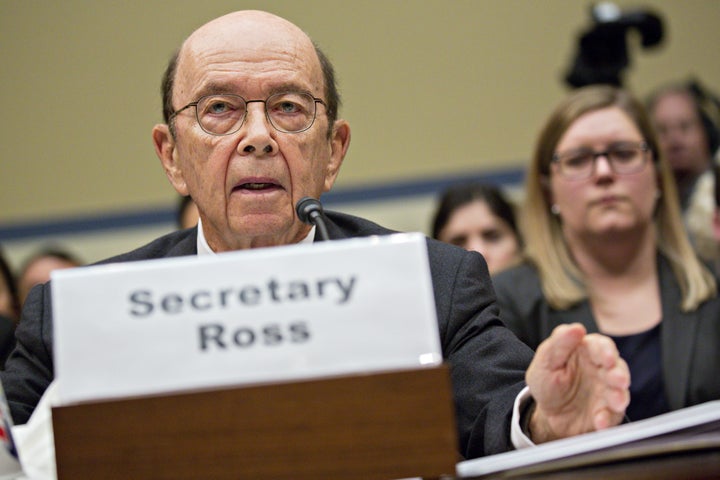WASHINGTON ― The Supreme Court appeared willing to allow the Trump administration to add a question asking every American household to identify citizens and noncitizens on the 2020 census.
The court appeared split along ideological lines during oral arguments Tuesday. The court’s more conservative justices, including Chief Justice John Roberts, noted that the census asks many questions beyond simply counting people and that it didn’t appear unreasonable to add a citizenship question. The court’s more liberal justices noted that Commerce Secretary Wilbur Ross had failed to ever articulate a rationale for why adding the citizenship question was the best way to go about getting the data the Trump administration wanted.
The Census Bureau’s own experts estimate that an additional 5.8% of households with a noncitizen are unlikely to respond on their own to the census, which goes out to every American household just once each decade. That translates to approximately 6.5 million people.
There are always going to be trade-offs between adding a question and gathering data, U.S. Solicitor General Noel Francisco argued. But in this case, Ross had made the calculation that the benefits of asking the citizenship question specifically outweighed the cost of a declining response rate.
The Trump administration’s official rationale for adding the question was that it needed better data to enforce the 1965 Voting Rights Act. Although the Justice Department has failed to clearly explain how the existing quality of data would hurt its voting rights enforcement efforts, Roberts noted that the census has long asked demographic questions unrelated to counting the actual population and wondered whether it would hurt the department’s efforts to have such data. He asked New York Solicitor General Barbara Underwood, who was representing the plaintiffs in the case, whether having the data wouldn’t support enforcing the landmark civil rights law.
“Do you think it wouldn’t help voting rights enforcement? The CVAP, Citizen Voting Age Population, is the critical element in voting rights enforcement, and this is getting citizen information,” he said. Underwood said there was no evidence that Ross specifically needed to add the citizenship question to get the data he needed.

Much of the time during Tuesday’s oral argument focused on a memo career Census Bureau officials wrote to Ross advising him against adding the citizenship question. The career officials recommended that Ross use existing governmental administrative records to gather citizenship data instead of adding the question. That methodology would produce much more reliable data without decreasing the likelihood people would respond, they said.
Although the Census Bureau’s recommendation was clear, Francisco portrayed Ross as having to choose between two uncertainties ― relying on modeling or adding the question. Ultimately, Ross believed adding the question, while also using administrative records, would give him the most accurate data. That conclusion was not supported by the Census Bureau.
“The addition of any particular demographic question is always going to be a trade-off between information and accuracy,” Francisco said. “What the secretary concluded was, in the face of uncertainty, he’d rather go with the bird in a hand and ask the question at 98 percent accuracy than an unknown and untested statistical model.”
Justice Brett Kavanaugh, who also appeared to favor the Trump administration, asked Underwood whether it would be appropriate to add a citizenship question, even if was unclear which method would produce more accurate citizenship data. Underwood replied that the uncertainty about the data was not enough to justify decreasing the response rate.
Justices Elena Kagan, Stephen Breyer and Sonia Sotomayor noted the advantages of using modeling and not asking a question were far clearer than Francisco suggested. They said evidence suggested Ross had a strong preference for adding the question and sought a justification for doing so. Kagan noted that the U.S. solicitor general had provided far more explanation and justification for Ross’ thinking than the commerce secretary himself had. The government’s position, she said, seemed like an attempt to justify a decision after the fact.
“The fact that SG lawyers can come up with 60 pages of explanation for a decision, that’s all post hoc rationalization,” said Kagan, a former U.S. solicitor general. “The question is, what did the secretary say? Where did he say it? When did he say it? What does it mean, other than just ipse dixit and conclusions?”
“This seems like he thought of something, ‘I want to add a citizenship question.’ I don’t know why. But this is a solution in search of a problem. ‘I’ve got to find a problem that fits what I want to do,’” Sotomayor said.
While the Trump administration says it will mitigate the decline in self-response through extensive follow-up efforts, experts say the most accurate data comes when people respond on their own.
There was also a tense exchange between Sotomayor and Francisco at the close of the argument when the solicitor general suggested that, under the plaintiffs’ theory of the case, anyone could get a question struck from the census if they objected to it and refused to answer.
“Are you suggesting that Hispanics are boycotting the census? Are you suggesting they don’t have, whether it is rational or not, that they don’t have a legitimate fear?” Sotomayor asked. Francisco said that’s not what he was suggesting but was arguing it was the type of behavior the challengers’ legal argument would allow.
An inaccurate census would have deep consequences; the data from the decennial survey is used to draw electoral districts and to determine how over $880 billion in federal funds get allocated each year. It also serves as a baseline for many pollsters to make sure that their samples are representative of the population. Businesses also rely on the data to make informed decisions about where they should expand and allocate resources.
“Why in the world would you want an inaccurate count?” asked Rep. Carolyn Maloney (D-N.Y.), who is a co-chair of the House Census Caucus.
In January, a federal judge in Manhattan ruled the process Commerce Secretary Ross used to add the citizenship question violated the Administrative Procedure Act, and he blocked officials from adding the question to the survey. The APA governs how agencies can implement policy and allows a court to review and block an action if it is “arbitrary, capricious,” or “an abuse of discretion.” U.S. District Judge Jesse Furman said Ross’ conduct clearly rose to that level, ruling Ross ignored and misconstrued evidence so he could reach his predetermined preference to add the question.
Two federal judges ― in California and Maryland, respectively ― have since also ruled the Trump administration violated the Constitution’s mandate that the census count all persons, in addition to running afoul of the APA.
But the Trump administration argues that Ross has broad discretion over what goes on the census and made the decision after weighing the benefits and drawbacks of doing so. Internal emails made public during litigation strongly undercut that rationale. The messages show Ross was interested in adding a citizenship question long before the Justice Department formally requested that he do so.
The Supreme Court expedited the case, Department of Commerce v. New York, because of the tight deadline the Census Bureau faces for printing the census forms. A ruling is expected by June. Census officials say they have two versions of the form, with and without a citizenship question, and will send to the printer whichever version complies with the court’s decision.
This story has been updated with more details and quotes from the oral arguments.
